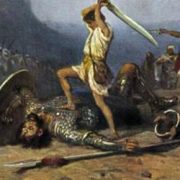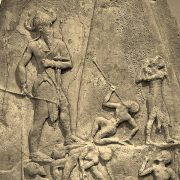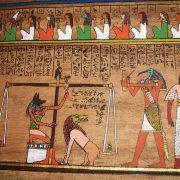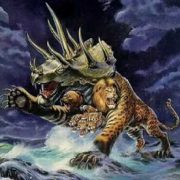A key thread woven through the fiction of H. P. Lovecraft was a fictional grimoire, or book of witchcraft, called the Necronomicon. The book, according to the Lovecraft canon, was written in the 8th century AD by the “Mad Arab,” Abdul Alhazred. This was a bit of wordplay, Lovecraft’s childhood nickname because of his love for the book 1001 Arabian Nights (Alhazred = “all has read”).
Lovecraft claimed inspiration for the Necronomicon came to him in a dream, and through his many letters to friends and colleagues he encouraged others to incorporate the mysterious tome into their own fiction. Over time, references to the Necronomicon by other authors led to a growing belief that the book was, in fact, real.
By the 1970s, Lovecraft’s work had found a new audience, and his stories were being mined by Hollywood. Then in 1977, a hardback edition of the Necronomicon suddenly appeared (published in a limited run of 666 copies!), edited by a mysterious figure known only as “Simon,” purportedly a bishop in the Eastern Orthodox Church. A mass market paperback edition followed a few years later. That version has reportedly sold more than a million copies over the last four decades.
Simon’s Necronomicon arrived on the wave of a renewed interest in the occult that washed over the Western world in the 1960s and ‘70s. Interestingly, it was a French journal of science fiction that helped spark the revival, and it did so by publishing the works of H. P. Lovecraft for a new audience. Planète was launched in the early ‘60s by Louis Pauwles and Jacques Bergier, and their magazine brought a new legion of admirers to the “bent genius.” More significantly for our study here, however, was the book Pauwles and Bergier co-authored in 1960, Les matins des magiciens (Morning of the Magicians), which was translated into English in 1963 as Dawn of Magic.
The book covered everything from pyramidology (the belief that the Egyptian pyramids held ancient secrets) to supposed advanced technology in the ancient world. Likewise, the authors praised Arthur Machen, the Irish author of horror fiction, about surviving Celtic mythological creatures, and they discussed the genius of H. P. Lovecraft in the same breath as the scientist Albert Einstein and psychoanalyst Carl Jung. From Lovecraft, Bergier and Pauwles borrowed the one thought that would be of more importance than any other in their book. As we have seen, Morning of the Magicians speculates that extraterrestrial beings may be responsible for the rise of the human race and the development of its culture, a theme Lovecraft invented (emphasis added).
The success of Pauwles and Bergier inspired others to explore the concepts they’d developed from the writings of Lovecraft. The most successful of these, without question, was Erich von Däniken’s Chariots of the Gods, the best-selling English language archaeology book of all time.
You can say one thing for von Däniken—he wasn’t shy about challenging accepted history:
I claim that our forefathers received visits from the universe in the remote past, even though I do not yet know who these extraterrestrial intelligences were or from which planet they came. I nevertheless proclaim that these “strangers” annihilated part of mankind existing at the time and produced a new, perhaps the first, homo sapiens.
The book had the good fortune of being published in 1968, the same year Stanley Kubrick’s epic adaptation of Arthur C. Clarke’s 2001: A Space Odyssey hit theaters. The film, based on the idea that advanced alien technology had guided human evolution, was the top-grossing film of the year, and was named the “greatest sci-fi film of all time” in 2002 by the Online Film Critics Society. By 1971, when Chariots of the Gods finally appeared in American bookstores, NASA had put men on the moon three times and the public was fully primed for what von Däniken was selling.
It’s hard to overstate the impact of Chariots of the Gods on the UFO research community and the worldviews of literally millions of people over the last fifty years. In 1973, Twilight Zone creator Rod Serling built a documentary around Chariots titled In Search of Ancient Astronauts, which featured astronomer Carl Sagan and Wernher von Braun, architect of the Saturn V rocket. The following year, a Chariots of the Gods feature film was released to theaters. By the turn of the 21st century, von Däniken had sold more than 60 million copies of his twenty-six books, all promoting the idea that our creators came from the stars.
This, despite the fact that von Däniken told National Enquirer in 1974 that his information came not through archaeological fieldwork but through out-of-body travel to a place called Point Aleph, “a sort of fourth dimension” outside of space and time.
To put it simply, the claims of von Däniken don’t hold water. His theories have been debunked in great detail and he’s even admitted to making things up, but lack of evidence has never stopped crazy ideas for long. And now, thanks to a new generation of true believers, Ancient Aliens and its imitators are still mining von Däniken gold five decades after his first book hit the shelves.
Ancient alien evangelists have effectively proselytized the American public since Chariots of the Gods went viral nearly fifty years ago. This may sound like a joke, but more adults in the United States believe that the earth is being visited by extraterrestrials than believe in God as He’s revealed Himself in the Bible.
MUFON, the Mutual UFO Network, which calls itself “the world’s oldest and largest UFO phenomenon investigative body,” has gone all in with ancient aliens in recent years. The group now openly supports pseudoscientific and New Age interpretations of the UFO phenomenon instead of sticking to what can be supported by evidence. For example, the theme of MUFON’s 2017 national convention was “The Case for a Secret Space Program,” which was described by one critic as “blatantly unscientific and irrational.”
The conference featured among its speakers a man who claims he was recruited for “a ‘20 & Back’ assignment which involved age regression (via Pharmaceutical means) as well as time regressed to the point of beginning service.” In plain English, he claims he served for two decades in an off-planet research project, and then was sent back in time to a few minutes after he left and “age-regressed” so no one noticed that that he’s really twenty years older than he looks.
Another speaker claimed he was pre-identified as a future president of the United States in a CIA/DARPA program called Project Pegasus, which purportedly gathered intel on past and future events, such as the identities of future presidents. He also claimed Barack Obama was his roommate in 1980 in a CIA project called Mars Jump Room, a teleportation program that sent trainees to a secret base on the red planet.
You know, it sounds really bizarre when we step back and summarize things but there is no way to make this sound rational. The horror fiction of H. P. Lovecraft, which was inspired by the spirits behind 19th century occultists like Helena Blavatsky (and possibly the same spirit that communicated with Aleister Crowley), was filtered through the French science-fiction scene in the 1960s, adapted by a Swiss hotel manager named von Däniken, and recycled back to the United States at the time of the first moon landings, where it’s grown into a scientistic religion that replaces God with aliens.
Wow.
To paraphrase our friend, Christian researcher and author L. A. Marzulli: Now fifty years on from the publication of Chariots of the Gods, the ancient alien meme is real, burgeoning, and not going away.
And the old gods are using it to set the stage for their return.

Derek Gilbert Bio
Derek P. Gilbert hosts SkyWatchTV, a Christian television program that airs on several national networks, the long-running interview podcast A View from the Bunker, and co-hosts SciFriday, a weekly television program that analyzes science news with his wife, author Sharon K. Gilbert.
Before joining SkyWatchTV in 2015, his secular broadcasting career spanned more than 25 years with stops at radio stations in Philadelphia, Saint Louis, Little Rock, and suburban Chicago.
Derek is a Christian, a husband and a father. He’s been a regular speaker at Bible prophecy conferences in recent years. Derek’s most recent book is The Great Inception: Satan’s PSYOPs from Eden to Armageddon. He has also published the novels The God Conspiracy and Iron Dragons, and he’s a contributing author to the nonfiction anthologies God’s Ghostbusters, Blood on the Altar, I Predict: What 12 Global Experts Believe You Will See by 2025, and When Once We Were a Nation.













Leave a Reply
Want to join the discussion?Feel free to contribute!